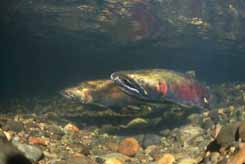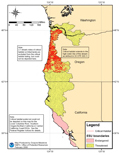Coho Salmon (Oncorhynchus kisutch)
Status | Taxonomy | Species Description | Habitat | Distribution |
Population Trends | Threats | Conservation Efforts | Regulatory Overview |
Key Documents | More Info
 Coho Salmon (Oncorhynchus kisutch) Photo: NMFS Northwest Fisheries Science Center |
|
|
Did You Know? · Another common name for coho salmon is silver salmon. |
|
|
Status
ESA Endangered - 1 ESU
ESA Threatened - 3 ESUs
ESA Species of Concern - 1 ESU
More information on all 7 coho salmon ESUs is available on NMFS Northwest Regional Office website.
Taxonomy
Kingdom: Animalia
Phylum: Chordata
Class: Osteichthyes
Order: Salmoniformes
Family: Salmonidae
Genus: Oncorhynchus
Species: kisutch
Species Description
The size of an adult coho may measure more than 2 feet (61 cm) in length and can weigh up to 36 pounds (16 kg). However, the average weight of adult coho is 8 pounds (3.6 kg).
Coho salmon have dark metallic blue or greenish backs with silver sides and a light belly and there are small black spots on the back and upper lobe of the tail while in the ocean. The gumline in the lower jaw has lighter pigment than does the Chinook salmon. Spawning fish in inland rivers are dark with reddish-maroon coloration on the sides.
Coho salmon adults migrate from a marine environment into freshwater streams and rivers of their birth in order to mate (called anadromy). They spawn only once and then die (called semelparity).
Adults return to their stream of origin to spawn and die, usually at around three years old. Some precocious males known as "jacks" return as two-year-old spawners. Spawning males develop a strongly hooked snout and large teeth. Females prepare several redds (nests) where the eggs will remain for six to seven weeks until they hatch.
As the time for migration to the sea approaches, juvenile coho salmon lose their parr marks, a pattern of vertical bars and spots useful for camouflage, and gain the dark back and light belly coloration used by fish living in open water. Their gills and kidneys also begin to change at this time so that they can process salt water.
In their freshwater stages, coho feed on plankton and insects, and switch to a diet of small fishes as adults in the ocean.
 Coho Salmon Critical Habitat (click for larger view PDF) |
Habitat
Coho spend approximately the first half of their life cycle rearing and feeding in streams and small freshwater tributaries. Spawning habitat is small streams with stable gravel substrates. The remainder of the life cycle is spent foraging in estuarine and marine waters of the Pacific Ocean.
Critical habitat was designated on May 5, 1999 for the Central California Coast and Southern Oregon/ Northern California Coast coho salmon.
Distribution
The species was historically distributed throughout the North Pacific Ocean from central California to Point Hope, Alaska, through the Aleutian Islands, and from the Anadyr River, Russia, south to Hokkaido, Japan. Coho probably inhabited most coastal streams in Washington, Oregon, and central and northern California. Some populations, now considered extinct, are believed to have migrated hundreds of miles inland to spawn in tributaries of the upper Columbia River in Washington, and the Snake River in Idaho. Coho still occur in Alaska as well.
Population Trends
The long term trend for the listed populations is still downward, though there was one recent good year with an increasing trend in 2001. For further details on specific populations, see the 2005 status review report [pdf] [6.3 MB].
Threats
Salmonid species on the west coast of the United States have experienced dramatic declines in abundance during the past several decades as a result of human-induced and natural factors. For more information, please visit our Pacific salmonids threats page.
Conservation Efforts
A variety of conservation efforts have been undertaken with some of the most common initiatives including captive-rearing in hatcheries, removal and modification of dams that obstruct salmon migration, restoration of degraded habitat, acquisition of key habitat, and improved water quality and instream flow.
The Pacific Coast Salmon Recovery Fund (PCSRF) was established by Congress in 2000 to support the restoration of salmon species. The fund is overseen by NMFS and carried out by state and tribal governments. The 2006 PCSRF report summarizes their work in detail.
No Pacific salmon have been evaluated for IUCN Redlist ![]() conservation status.
conservation status.
Regulatory Overview
The threatened and endangered ESUs of coho salmon were listed on June 28, 2005. Some of them had been previously listed in 1996 or 1997, but, because of legal and other issues, all listings were reaffirmed in 2005. The Central California Coastal ESU was uplisted from threatened to endangered in the 2005 listing.
The Puget Sound/Strait of Georgia ESU was listed as a Species of Concern on April 15, 2004.
A final critical habitat designation was published on May 5, 1999 for Central California Coast and Southern Oregon/Northern California Coasts coho salmon.
See Key Documents below for more details.
Key Documents
(All documents are in PDF format.)
| Title | Federal Register | Date |
|---|---|---|
| Federal Register Notices for Coho Salmon | various | various |
| Recovery Plans and Related Documents | n/a | n/a |